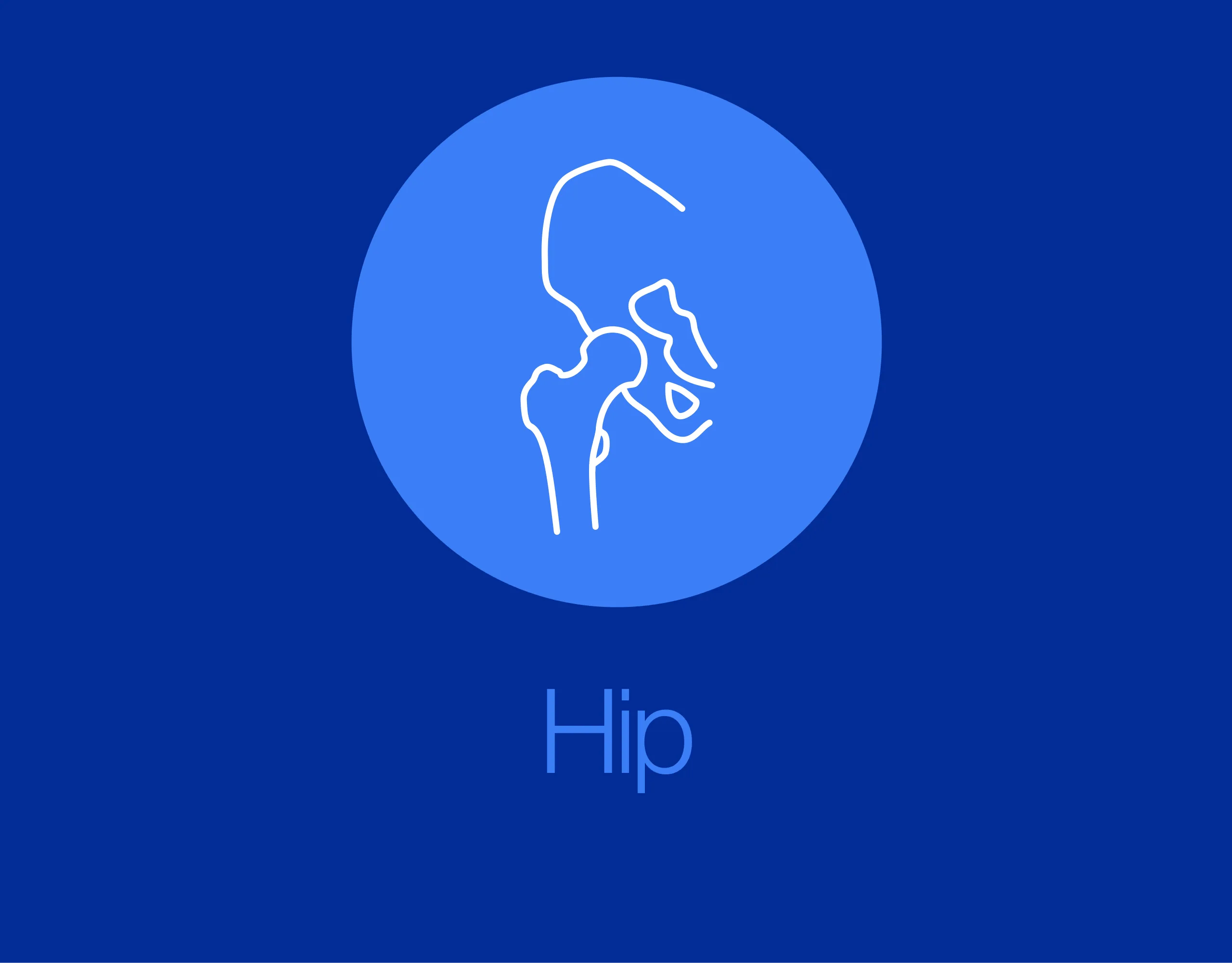ORIF through sequential approaches
1. General considerations
General remarks for sequential approaches
Any anterior approach ( modified Stoppa or ilioinguinal approach) can be combined with any posterior approach. Here a combination of the Stoppa approach and the prone Kocher-Langenbeck approach is illustrated as the easiest and most reliable combination.
Sequence of the treatment
For ORIF of T-shape fractures with a sequential approach, the following surgical sequence is common:
- Patient positioning supine for modified Stoppa approach
- Direct reduction of the anterior column
- Assessment of reduction
- Fixation of the anterior column avoiding the posterior column
- Wound closure
- Patient positioning prone for Kocher-Langenbeck approach
- Direct reduction of the posterior column
- Assessment of reduction
- Fixation of the posterior column
Planning/templating
Preoperative templating is essential for understanding the complexity of an acetabular fracture.
When using implants on the innominate bone, it is important to know the best starting points for obtaining optimal screw anchorage (see General stabilization principles and screw directions).
Indirect visualization
Unusually for a significant joint, articular reduction of acetabular fractures is indirect. The articular surface of the hip joint is not seen directly. Reduction must be assessed by the appearance of the extraarticular fracture lines and intraoperative fluoroscopic assessment. Some fracture lines are palpated manually but not seen directly such as transverse fracture lines on the quadrilateral plate.
Quality of reduction
Posttraumatic arthrosis is directly related to the quality of reduction - the better the reduction, the greater the chance of a good or excellent result.
2. Joint distraction
Traction can be applied in several ways with:
- The use of a fracture table that allows longitudinal and lateral traction
- The intermittent help of an assistant (may be unreliable in long procedures)
Apply longitudinal traction to the lower limb, and lateral traction through the greater trochanter.
Both these forces should be combined until the best effect is obtained.
In some surgeon’s experience, the use of a traction table post or other traction frame is helpful during this operation.
Note
Excessive traction may limit fracture fragment mobility and interfere with reduction.
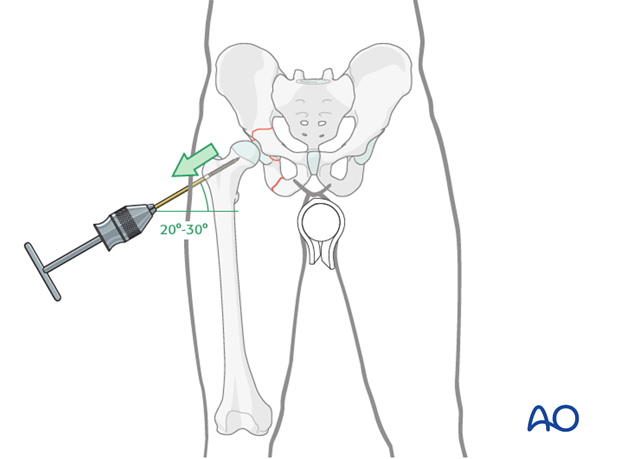
Teaching video
AO teaching video: Use of the distractor on the pelvis
3. Cleaning of the fracture site
Fracture sites are prepared by preliminarily increasing the displacement and then removing early callus and granulation tissue.
Joint distraction is extremely useful to facilitate this debridement.
4. Anterior column: reduction
Reduction clamps can be placed from the supraacetabular surface to the area of the iliopectineal surface on the inner table of the pelvis in similar positions to those used on the outside of the pelvis through an extended iliofemoral approach.
The illustration shows placement of a pointed reduction forceps.
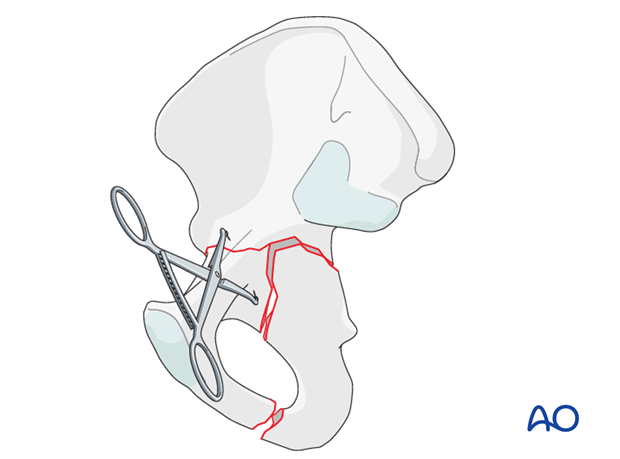
Alternative for anterior column reduction is the oblique pelvic reduction (quadrangular) clamp.
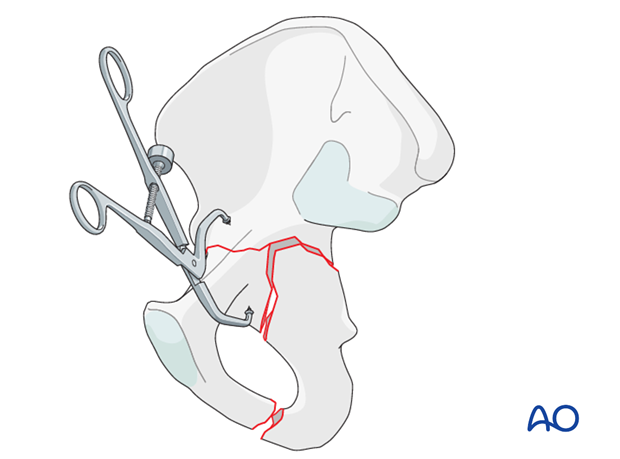
5. Anterior column: fixation
A contoured pelvic brim plate is used through the Stoppa approach. This plate can be contoured to extend across the low anterior column to the pubis, as required by the specific fracture.
After reduction and fixation of the anterior column in a singular approach, the posterior column would now be reduced onto the stable anterior column and fixation of the posterior column occurs through the pelvic brim buttress plate.
In a sequential approach, this fixation is completed with the second part of the procedure through the posterior approach.

Contouring and applying a pelvic brim plate
The plate must be long enough to provide adequate fixation of both posterior and anterior injuries. This typically requires extension to the pubic body.
The use of a malleable template aids plate contouring.
Because the primary purpose of this plate is to buttress the anterior column, posterior contouring is most critical. For this reason, plate fixation normally starts posteriorly and proceeds anteriorly. Final adjustment of the plate profile can be achieved in situ, due to plate malleability.
Tools for in situ plate contouring include the ball spike for pushing, ...
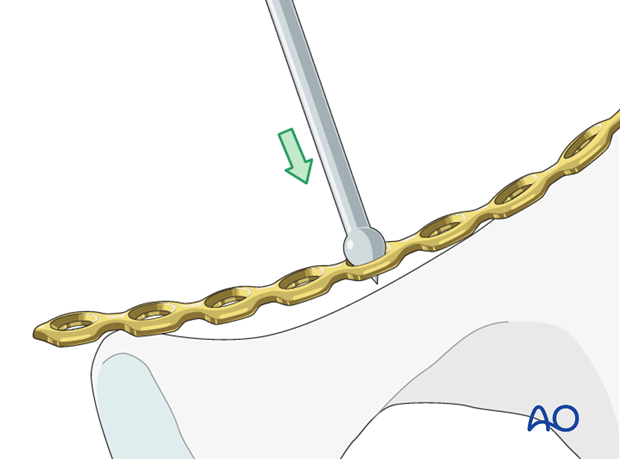
... and large and small fragment screwdrivers for torsional adjustment.
Apply the plate along the pelvic brim spanning from the innominate bone adjacent to the SI joint to the pubis.
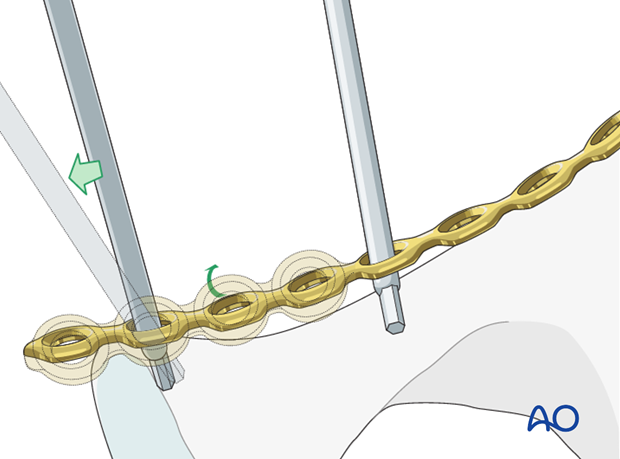
Plate fixation of the anterior column
The cranial most screws are placed parallel to the SI joint, anchoring the plate to the sciatic buttress. This provides assistance with the reduction (as previously described) as well as definitive buttress stabilization of the anterior column.
Screws can be placed through the plate into the reduced anterior column fragment, depending on the fracture morphology.
At this point, it is critical to ensure that no screws cross into the posterior column fracture or fragment. This would block the reduction of the posterior column fragments.

6. Posterior column: reduction
Repositioning of the patient and Kocher-Langenbeck approach
At this stage of the surgery the anterior exposure is closed, the patient is repositioned prone and the posterior column exposed through the Kocher-Langenbeck approach.
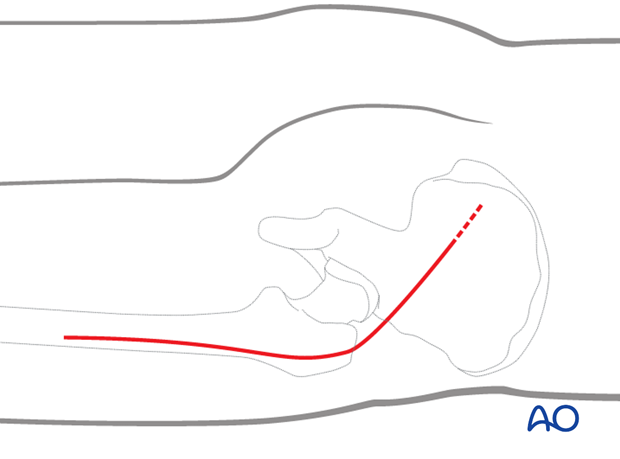
Ischial Schanz screw as a handle
A Schanz screw is placed into the ischial tuberosity to act as a handle or joystick. This is a key aid for manipulating the posterior column fragment.
The orientation of the screw is directed from lateral to medial and is typically applied through the muscular insertions overlaying the tuberosity. The muscles do not need to be elevated from the bone to allow screw placement.
Care should be taken to avoid blocking the fracture environment with this screw. A proximal to distal trajectory should be avoided, as the Schanz screw will block subsequent adjuncts for fracture reduction at the retroacetabular surface.
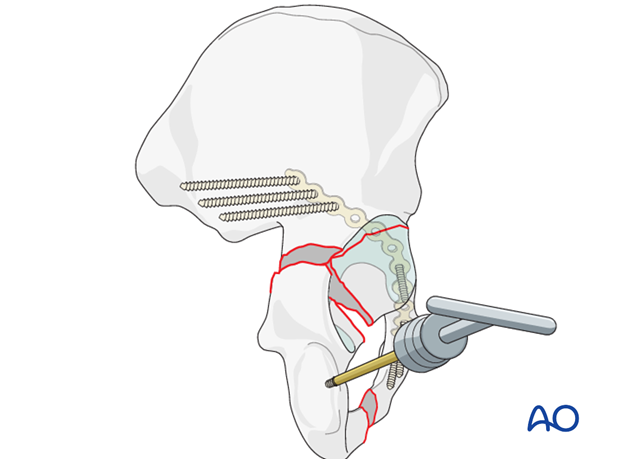
Use of pointed push pull devices
Fracture adjustment requires fine manipulation at the fracture itself. There are several adjuncts that can accomplish this fine adjustment.
Rotation and fine adjustment of this fragment is aided with a bone hook, sharp dental hooks, and/or ball spike pusher.
Manipulation with a hook placed as shown demonstrates mobility of the posterior column, and helps in the reduction. If reduction is difficult, check the fracture site for interposed debris.

Use of pointed reduction forceps
The pointed reduction forceps is a very powerful way of manipulating the reduction along the fracture line and applying compression.
Due to the convexity of the bone, small holes may need to be drilled into the cortex to allow clamp application, and to prevent the points from slipping.
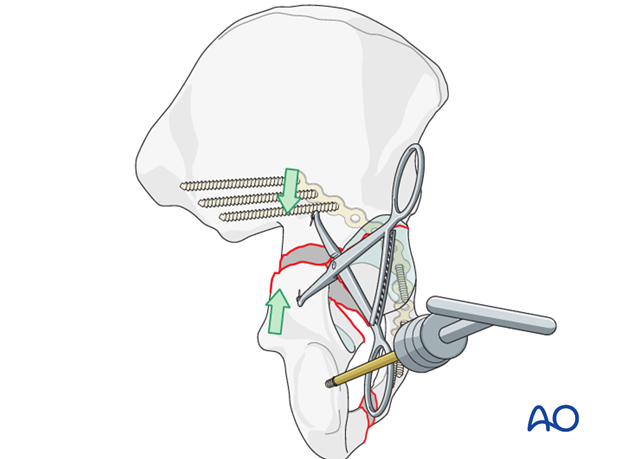
Use of a Farabeuf clamp
This clamp has jaws shaped to fit around screw heads. It can be used to compress fracture surfaces with two properly placed 3.5 mm cortical screws. They should be securely placed, and a little prominent, to be grasped by the clamp.
Properly placed, this clamp can both de-rotate the posterior column, and approximate the fracture fragments.
Care should be taken, as poor clamp placement may pressure the sciatic nerve.
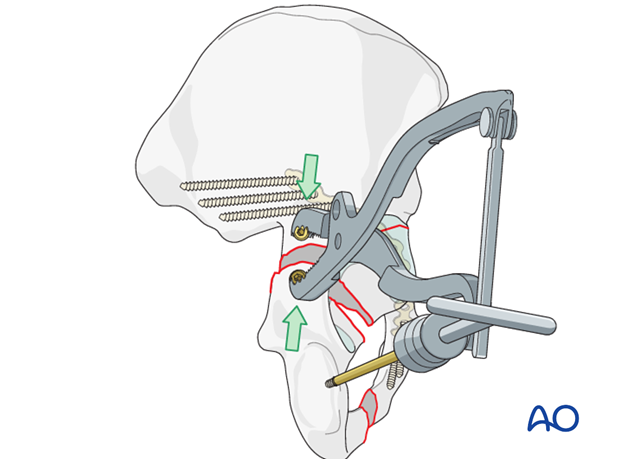
Use of a Jungbluth clamp
The Jungbluth pelvic reduction clamp is a similar alternative, which requires a larger exposure and also depends upon proper screw placement so that the forces applied by the clamp correctly realign the fracture.
A proximal screw is placed in the superior portion of the iliac wing above the acetabulum.
A distal screw is placed in the posterior column above the ischial tuberosity.
Their positions determine the direction of applied force, and this must be perpendicular to the fracture plane.
The use of the screw-dependent clamps (the Jungbluth and Farabeuf) creates the potential problem of screw traffic. Care must be taken to avoid placing these screws in the way of provisional and definitive fixation screws.
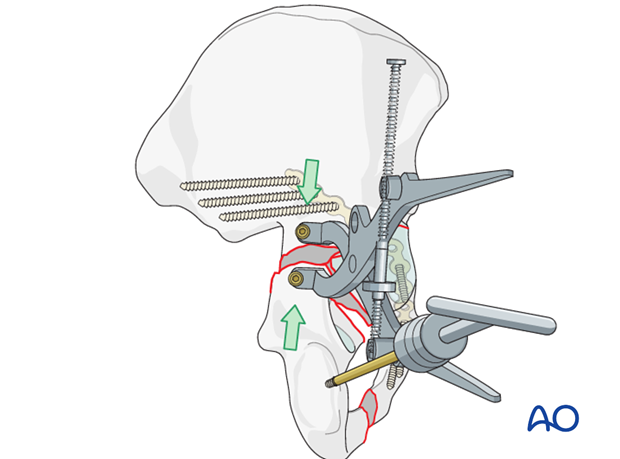
Articular surface reduction
In the elementary posterior column fracture, the articular surface cannot be easily visualized once the fracture has been reduced. This is different than the associated posterior column/wall fracture, in which the posterior column articular reduction can be assessed through the displaced posterior wall fragment.
Intraarticular inspection may be possible by opening the hip capsule with an incision parallel to the acetabular border, avoiding damage to the labrum. Inspection of the joint surface demonstrates reduction.
The reduction of the cortical surfaces of the fracture acts as a surrogate for articular reduction. Visualization of the fraction line along the cortical retroacetabular surface and palpation of the fracture along the quadrilateral surface together indicate the quality of the obtained reduction.
Examine the reduction by inserting a finger or an appropriate instrument along the quadrilateral plate. With a satisfactory reduction, the quadrilateral surface should have no palpable gap or step-off.

Additional manipulation of translation and rotation of the posterior column fragment should occur until both the internal palpation and external visualization demonstrate an anatomical reduction.
To mobilize the posterior column in cases older than 3 weeks, cut the sacrospinous ligament at its insertion on the ischial spine to aid mobilization of the fragment.
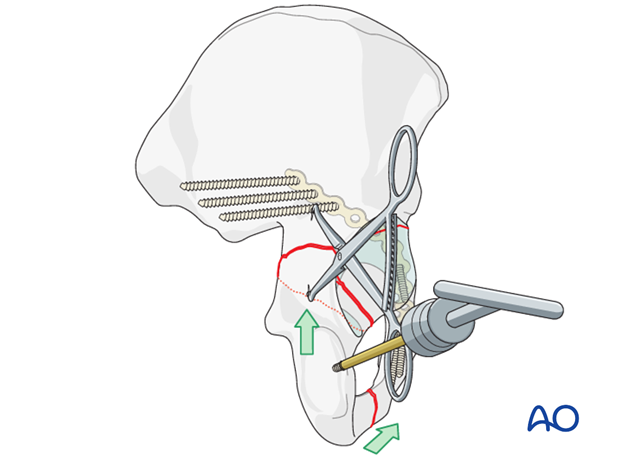
7. Posterior column: fixation
Interfragmentary lag screw
If possible, begin definitive fixation with an interfragmentary lag screw, placed from the distal fragment, into the posterior buttress of the ilium. The trajectory of this screw often requires a percutaneous insertion through the posterior gluteus musculature. Great care must be taken not to compromise the sciatic nerve.
The gliding hole may be drilled before reduction to ensure its proper placement.
Screw placement must allow optimal plate positioning as described below.
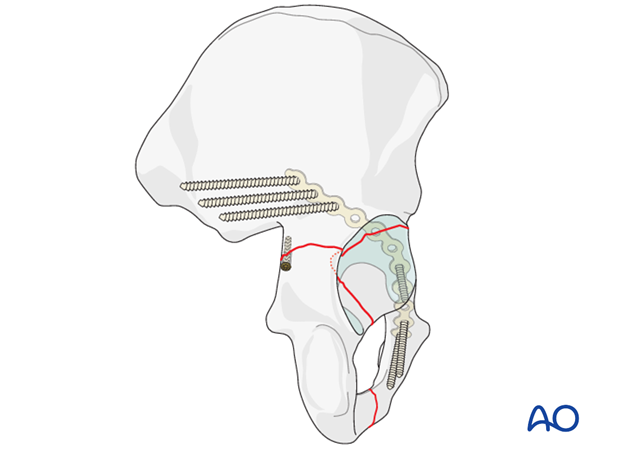
Contouring of the plate with a template
In addition to the lag screw, a reconstruction plate will be applied. The two points of fixation will provide torsional stability to the ultimate construct.
A reconstruction plate is chosen to reconstitute the structural stability of the native posterior column and the sciatic buttress. Ideally, it will be applied to the mid-column and contoured to obtain purchase in the strong bone of the sciatic buttress.
An aluminum template can be bent to fit the pelvis in the optimal location. The plate positioning will be limited cranially by the superior gluteal nerve and vascular pedicle. The distal end of the plate will be contoured to optimize screw positioning down the ischial ramus.
The plate contour should enforce the vectors required for the reduction.
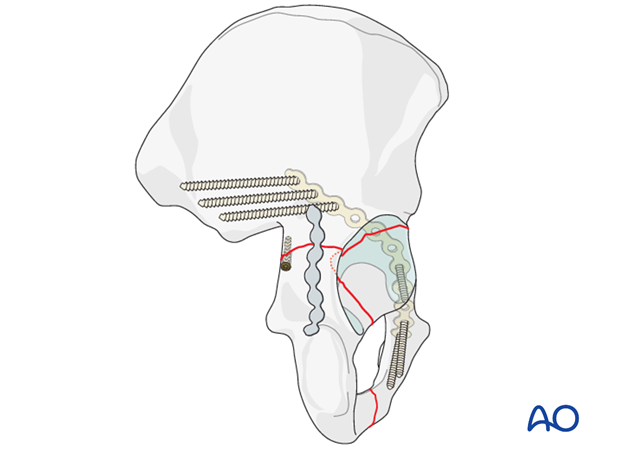
Application of the reconstruction plate
Definitive stabilization is obtained by adding the reconstruction plate spanning the posterior column and anchored securely to the ilium and ischium.
The screws placed in the periarticular portion of the plate must be positioned carefully to avoid intraarticular perforation. This becomes more probable as the plate is positioned laterally and closer to the acetabular rim.
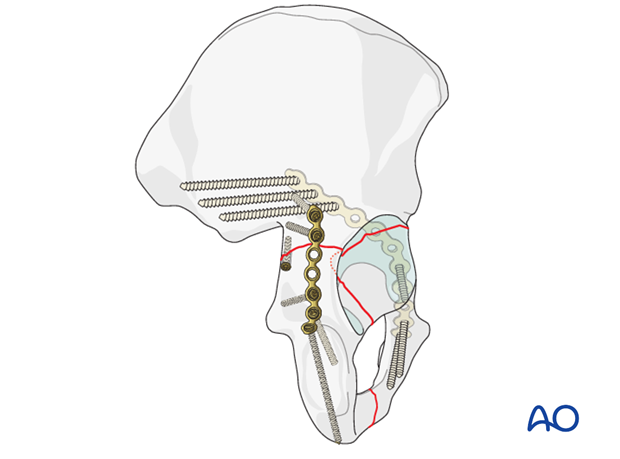
Pitfall: Injury to gluteal vessels and nerve
Proximally, retraction and plate and screw placement may result in neurovascular injury. Careful retraction and attention to plate location are essential to protect these fragile structures.
8. Radiographic assessment
Intraoperative confirmation of hardware position
During reduction and fixation, take fluoroscopic images in AP, iliac, and obturator oblique views to confirm reduction and/or screw placement.
To confirm that the lag screws are extraarticular an image exposed with the fluoroscope’s central ray superimposed on the long axis of the screw is taken.
Final radiographic assessment
Once all fixation is in place, confirm the appropriate appearance of AP, obturator oblique and iliac oblique views and check the location of any screw that is placed near the hip joint.
The AP view should be inspected to assure that congruence has been obtained. The femoral head should have the same relationship to the radiological roof, the anterior rim and the posterior rim as on the contralateral side.
If the low anterior column was affected, the obturator foramen profile and symphysis should be inspected to assess the quality of the distal reduction.
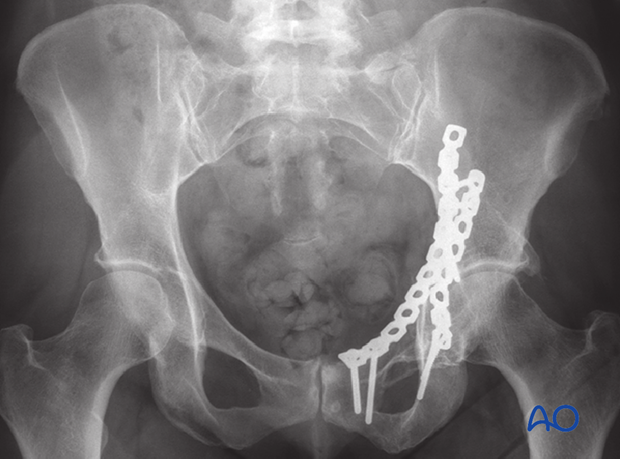
The obturator oblique should be inspected to ensure that there is no residual subluxation of the femoral head. The reduction of the anterior column should be assessed.
If a posterior wall fragment was involved, it should be seen as reduced and stabilized on this image.
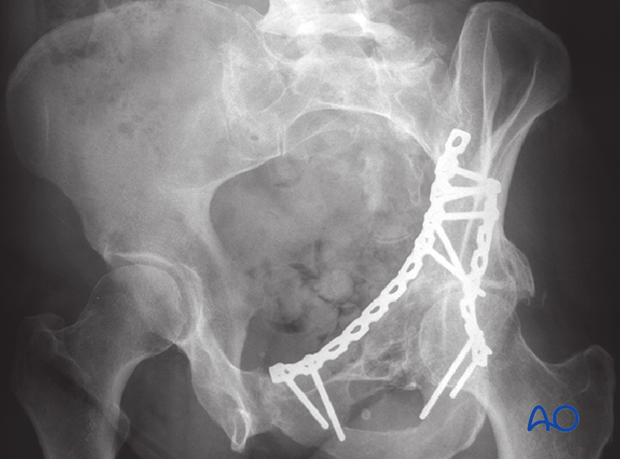
The iliac oblique should be inspected to ensure that the posterior column reduction is anatomic. The screws directed down the posterior column should be inspected and verified as extraarticular.
Postoperatively, obtain formal high-quality radiographs of AP and both oblique views.
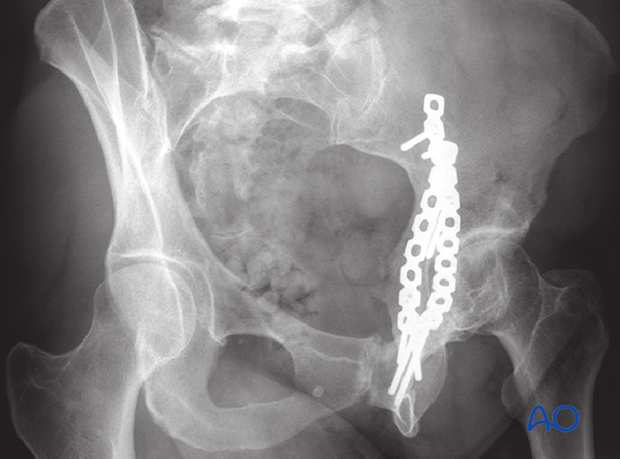
9. Postoperative care
During the first 24-48 hours, antibiotics are administered intravenously, according to hospital prophylaxis protocol. In order to avoid heterotopic ossification in high-risk patients, the use of indomethacin or single low dose radiation should be considered. Every patient needs DVT treatment. There is no universal protocol, but 6 weeks of anticoagulation is a common strategy.
Wound drains are rarely used. Local protocols should be followed if used, aiming to remove the drain as soon as possible and balancing output with infection risk.
Specialized therapy input is essential.
Follow up
X-rays are taken for immediate postoperative control, and at 8 weeks prior to full weight bearing.
Postoperative CT scans are used routinely in some units, and only obtained if there are concerns regarding the quality of reduction or intraarticular hardware in others.
With satisfactory healing, sutures are removed around 10-14 days after surgery.
Mobilization
Early mobilization should be stressed and patients encouraged to sit up within the first 24-48 hours following surgery.
Mobilization touch weight bearing for 8 weeks is advised.
Weight bearing
The patient should remain on crutches touch weight bearing (up to 20 kg) for 8 weeks. This is preferable to complete non-weight bearing because forces across the hip joint are higher when the leg is held off the floor. Weight bearing can be progressively increased to full weight after 8 weeks.
With osteoporotic bone or comminuted fractures, delay until 12 weeks may be considered.
Implant removal
Generally, implants are left in situ indefinitely. For acute infections with stable fixation, implants should usually be retained until the fracture is healed. Typically, by then a treated acute infection has become quiescent. Should it recur, hardware removal may help prevent further recurrences. Remember that a recurrent infection may involve the hip joint, which must be assessed in such patients with arthrocentesis. For patients with a history of wound infection who become candidates for total hip replacement, a two-stage reconstruction may be appropriate.
Sciatic nerve palsy
Posterior hip dislocation associated with posterior wall, posterior column, transverse, and T-shaped fractures can be associated with sciatic nerve palsy. At the time of surgical exploration, it is very rare to find a completely disrupted nerve and there are no treatment options beyond fracture reduction, hip stabilization and hemostasis. Neurologic recovery may take up to 2 years. Peroneal division involvement is more common than tibial. Sensory recovery precedes motor recovery and it is not unusual to see clinical improvement in the setting of grossly abnormal electrodiagnostic findings.
